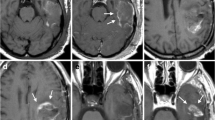Abstract
Improvements in imaging are increasing the detection of multiple lesions in the setting of glioblastoma. Occasionally distant non-enhancing lesions may be identified which have the appearances of a multicentric low-grade glioma. We aimed to determine the incidence, prognostic significance and diagnostic value of this appearance in new glioblastoma patients. Pre-operative MRIs of patients with a new diagnosis of glioblastoma were reviewed to identify multicentric non-enhancing lesions, defined as areas of FLAIR hyperintensity and mass effect, without post-contrast enhancement, separate from the histologically-proven glioblastoma. Patient survival was compared to glioblastoma patients without these appearances, and follow-up imaging was reviewed. Nine of 151 patients (6 %) had multicentric non-enhancing lesions. Their median survival of 183 days was significantly worse than the 278 days for patients without multicentric nonenhancing lesions (p = 0.025). Follow-up MRIs were performed in four patients. In one patient, there were several additional lesions, one of which developed evidence of necrosis within 22 days of presentation. In the other three patients, the multicentric lesions developed enhancement and evidence of necrosis within 1 year, and became confluent on FLAIR with the dominant lesion. The appearance of a multicentric non-enhancing lesion is an uncommon finding in glioblastoma, but a poor prognostic feature. These lesions progress faster than expected for a low-grade glioma and are thus likely to represent more advanced lesions than their appearances suggest. Confluence with the dominant lesion developing with time suggests that the tumor is more extensive than appreciated on imaging.


Similar content being viewed by others
References
Thomas RP, Xu LW, Lober RM, Li G, Nagpal S (2013) The incidence and significance of multiple lesions in glioblastoma. J Neurooncol 112(1):91–97. doi:10.1007/s11060-012-1030-1
Kyritsis AP, Levin VA, Alfred Yung WK, Leeds NE (1993) Imaging patterns of multifocal gliomas. Eur J Radiol 16(3):163–170. doi:10.1016/0720-048X(93)90063-S
Hassaneen W, Levine NB, Suki D, Salaskar AL, de Moura Lima A, McCutcheon IE, Prabhu SS, Lang FF, DeMonte F, Rao G, Weinberg JS, Wildrick DM, Aldape KD, Sawaya R (2011) Multiple craniotomies in the management of multifocal and multicentric glioblastoma. J Neurosurg 114(3):576–584. doi:10.3171/2010.6.JNS091326
Salvati M, Cervoni L, Celli P, Caruso R, Gagliardi FM (1997) Multicentric and multifocal primary cerebral tumours. Methods of diagnosis and treatment. Ital J Neurol Sci 18(1):17–20. doi:10.1007/bf02106225
Salvati M, Caroli E, Orlando E, Frati A, Artizzu S, Ferrante L (2003) Multicentric glioma: our experience in 25 patients and critical review of the literature. Neurosurg Rev 26(4):275–279. doi:10.1007/s10143-003-0276-7
Lasocki A, Gaillard F, Tacey M, Drummond K, Stuckey S (2016) Incidence and prognostic significance of non-enhancing cortical signal abnormality in glioblastoma. J Med Imaging Radiat Oncol 60(1):66–73. doi:10.1111/1754-9485.12421
Lasocki A, Tsui A, Tacey MA, Drummond KJ, Field KM, Gaillard F (2015) MRI grading versus histology: predicting survival of World Health Organization grade II-IV astrocytomas. Am J Neuroradiol 36(1):77–83. doi:10.3174/ajnr.A4077
Barajas RF, Phillips JJ, Parvataneni R, Molinaro A, Essock-Burns E, Bourne G, Parsa AT, Aghi MK, McDermott MW, Berger MS, Cha S, Chang SM, Nelson SJ (2012) Regional variation in histopathologic features of tumor specimens from treatment-naive glioblastoma correlates with anatomic and physiologic MR Imaging. Neurooncol 14 (7):942–954. doi:10.1093/neuonc/nos128
Tang C, Guo J, Chen H, Yao C-J, Zhuang D-X, Wang Y, Tang W-J, Ren G, Yao Y, Wu J-S, Mao Y, Zhou L-F (2015) Gene mutation profiling of primary glioblastoma through multiple tumor biopsy guided by (1)H-magnetic resonance spectroscopy. Int J Clin Exp Pathol 8(5):5327–5335
Carrillo JA, Lai A, Nghiemphu PL, Kim HJ, Phillips HS, Kharbanda S, Moftakhar P, Lalaezari S, Yong W, Ellingson BM, Cloughesy TF, Pope WB (2012) Relationship between tumor enhancement, edema, IDH1 mutational status, MGMT promoter methylation, and survival in glioblastoma. Am J Neuroradiol 33(7):1349–1355. doi:10.3174/ajnr.A2950
Terakawa Y, Yordanova YN, Tate MC, Duffau H (2013) Surgical management of multicentric diffuse low-grade gliomas: functional and oncological outcomes. J Neurosurg 118(6):1169–1175. doi:10.3171/2013.2.JNS121747
Jain R, Poisson LM, Gutman D, Scarpace L, Hwang SN, Holder CA, Wintermark M, Rao A, Colen RR, Kirby J, Freymann J, Jaffe CC, Mikkelsen T, Flanders A (2014) Outcome prediction in patients with glioblastoma by using imaging, clinical, and genomic biomarkers: focus on the nonenhancing component of the tumor. Radiology 272(2):484–493. doi:10.1148/radiol.14131691
Muccio C, Tarantino A, Esposito G, Cerase A (2011) Differential diagnosis by unenhanced FLAIR T2-weighted magnetic resonance images between solitary high grade gliomas and cerebral metastases appearing as contrast-enhancing cortico-subcortical lesions. J Neurooncol 103(3):713–717. doi:10.1007/s11060-010-0454-8
Stuckey SL, Wijedeera R (2008) Multicentric/multifocal cerebral lesions: can fluid-attenuated inversion recovery aid the differentiation between glioma and metastases? J Med Imaging Radiat Oncol 52(2):134–139. doi:10.1111/j.1440-1673.2008.01931.x
Tang YM, Ngai S, Stuckey S (2006) The solitary enhancing cerebral lesion: can FLAIR aid the differentiation between glioma and metastasis? Am J Neuroradiol 27(3):609–611
Acknowledgments
This study was supported by a RANZCR research grant in 2014.
Author information
Authors and Affiliations
Corresponding author
Ethics declarations
Conflict of interest
The authors declare that they have no conflict of interest.
Ethical approval
Institutional Human Research Ethics Committee approval was obtained and the study was performed in accordance with the ethical standards laid down in the 1964 Declaration of Helsinki and its later amendments.
Informed consent
Informed consent was not considered necessary by the Ethics Committee.
Rights and permissions
About this article
Cite this article
Lasocki, A., Gaillard, F., Tacey, M.A. et al. The incidence and significance of multicentric noncontrast-enhancing lesions distant from a histologically-proven glioblastoma. J Neurooncol 129, 471–478 (2016). https://doi.org/10.1007/s11060-016-2193-y
Received:
Accepted:
Published:
Issue Date:
DOI: https://doi.org/10.1007/s11060-016-2193-y




